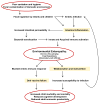Environmental enteropathy: critical implications of a poorly understood condition
- PMID: 22633998
- PMCID: PMC3372657
- DOI: 10.1016/j.molmed.2012.04.007
Environmental enteropathy: critical implications of a poorly understood condition
Abstract
Environmental enteropathy (also called tropical enteropathy) is a subclinical condition caused by constant fecal-oral contamination and resulting in blunting of intestinal villi and intestinal inflammation. Although these histological changes were discovered decades ago, the clinical impact of environmental enteropathy is just starting to be recognized. The failure of nutritional interventions and oral vaccines in the developing world may be attributed to environmental enteropathy, as the intestinal absorptive and immunologic functions are significantly deranged. Here we review the existing literature and examine potential mechanisms of pathogenesis for this poorly understood condition.
Copyright © 2012 Elsevier Ltd. All rights reserved.
Figures




References
-
- Solón Pablo. The Human Right to Water and Sanitation. 64th General Assembly Plenary, United Nations; New York, New York. 28 July 2010.
-
- Sullivan PB, et al. Chronic diarrhea and malnutrition--histology of the small intestinal lesion. Journal of Pediatric Gastroenterology and Nutrition. 1991;12:195–203. - PubMed
-
- Prentice A. Nutrient requirements for growth, pregnancy, and lactation: the Keneba experience. SAfr J Clin Nutr. 1993;6:33–38.
Publication types
MeSH terms
Substances
Grants and funding
LinkOut - more resources
Full Text Sources
Other Literature Sources
Medical

